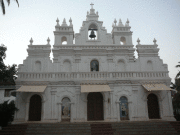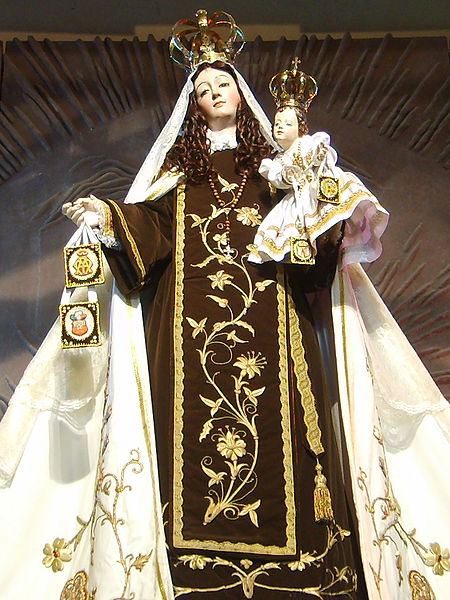
Our Lady of Mount Carmel

Our Lady of Mount Carmel is the title given to the Blessed Virgin Mary in her role as patroness of the Carmelite Order. The first Carmelites were Christian hermits living on Mount Carmel in the Holy Land during the late 12th and early to mid 13th century. They built in the midst of their hermitages a chapel which they dedicated to the Blessed Virgin, whom they conceived of in chivalric terms as the “Lady of the place.” Our Lady of Mount Carmel is the patron saint of Chile.
Since the 15th century, popular devotion to Our Lady of Mount Carmel has centered on the Scapular of Our Lady of Mount Carmel also known as the Brown Scapular, a sacramental associated with promises of Mary’s special aid for the salvation of the devoted wearer. Traditionally, Mary is said to have given the Scapular to an early Carmelite named Saint Simon Stock. The liturgical feast of Our Lady of Mount Carmel is celebrated on 16 July.
The solemn liturgical feast of Our Lady of Mount Carmel was probably first celebrated in England in the later part of the 14th century. Its object was thanksgiving to Mary, the patroness of the Carmelite Order, for the benefits she had accorded to it through its rocky early existence. The institution of the feast may have come in the wake of the vindication of their title “Brothers of the Blessed Virgin Mary” at Cambridge, England in 1374. The date chosen was 17 July; on the European mainland this date conflicted with the feast of St. Alexis, necessitating a shift to 16 July, which remains the Feast of Our Lady of Mount Carmel throughout the Catholic Church. The Latin poem Flos Carmeli (meaning “Flower of Carmel”) first appears as the sequence for this Mass.
The Feast of Our Lady of Mount Carmel is known to many Catholic faithful as the “scapular feast,” associated with the Brown Scapular of Our Lady of Mount Carmel, a devotional sacramental signifying the wearer’s consecration to Mary and affiliation with the Carmelite Order. A tradition first attested to in the late 14th century says that Saint Simon Stock, an early prior general of the Carmelite Order, had a vision of the Blessed Virgin Mary in which she gave him the Brown Scapular which formed part of the Carmelite habit, promising that those who died wearing the scapular would be saved.
That there should be a connection in people’s minds between the scapular, the widely popular devotion originating with the Carmelites, and this central Carmelite feast day, is surely not unnatural or unreasonable. But the liturgical feast of Our Lady of Mount Carmel did not originally have a specific association with the Brown Scapular or the tradition of a vision of the Blessed Virgin Mary. In 1642, a Carmelite named Fr. John Cheron, responding to scholarly criticism that Saint Simon Stock’s vision may not have historically occurred (these doubts are echoed by historians today), published a document which he said was a letter written in the 13th century by Saint Simon Stock’s secretary, “Peter Swanington”. Historians conclude that this letter was forged, likely by Cheron himself. It was nevertheless uncritically embraced by many promoters of the scapular devotion. The forged document’s claim of 16 July 1251 as the date of the vision (16 July being the date of the Feast of Our Lady of Mount Carmel) subsequently led to a strong association between this feast day, and the scapular devotion, and in the intervening years until the late 1970s, this association with the scapular was also reflected in the liturgy for that day. The Feast of Our Lady of Mount Carmel as well as that of Saint Simon Stock came under scrutiny after Vatican II due to historical uncertainties, and today neither of these liturgies, even in the Carmelite proper, make reference to the scapular.
In Spain and other Spanish-speaking countries Carmen, or María del Carmen has been traditionally a very common girl’s name.
The Carmelites see in the Blessed Virgin Mary a perfect model of the interior life of prayer and contemplation to which Carmelites aspire, a model of virtue, as well as the person who was closest in life to Jesus Christ. She is seen as the one who points Christians most surely to Christ, saying to all what she says to the servants at the wedding at Cana, “Do whatever he [Jesus] tells you.” Carmelites look to the Virgin Mary as a Spiritual Mother. The Stella Maris Monastery on Mount Carmel, named after a traditional title of the Blessed Virgin Mary, is considered the spiritual headquarters of the order.
Fr. Gabriel of St. Mary Magdalene de’ Pazzi, OCD, a revered authority on Carmelite spirituality, wrote that devotion to Our Lady of Mount Carmel means:
“O most beautiful flower of Mt. Carmel, fruitful vine, splendor of Heaven, Blessed Mother of the Son of God, Immaculate Virgin, assist me in my necessity. O Star of the Sea, help me and show me you are my Mother. O Holy Mary, Mother of God, Queen of Heaven and earth, I humbly beseech you from the bottom of my heart to succor me in this necessity (make request). There are none that can withstand your power. O Mary, conceived without sin, pray for us who have recourse to thee. Sweet Mother I place this cause in your hands. Amen.”
A 1996 doctrinal statement approved by the Congregation for Divine Worship and the Discipline of the Sacraments states that “Devotion to Our Lady of Mount Carmel is bound to the history and spiritual values of the Order of the Brothers of the Blessed Virgin Mary of Mount Carmel and is expressed through the scapular. Thus, whoever receives the scapular becomes a member of the order and pledges him/herself to live according to its spirituality in accordance with the characteristics of his/her state in life.”
According to the ways in which the Church has intervened at various times to clarify the meaning and privileges of the Brown Scapular: “The scapular is a Marian habit or garment. It is both a sign and pledge. A sign of belonging to Mary; a pledge of her motherly protection, not only in this life but after death. As a sign, it is a conventional sign signifying three elements strictly joined: first, belonging to a religious family particularly devoted to Mary, especially dear to Mary, the Carmelite Order; second, consecration to Mary, devotion to and trust in her Immaculate Heart; third an urge to become like Mary by imitating her virtues, above all her humility, chastity, and spirit of prayer.”
Our Lady of Mount Carmel has been related with Purgatory where souls are purged of sins in the fires, from centuries ago. In some cases, she is shown accompanied with angels and souls wearing Brown Scapulars, who plead for her mediation. In 1613, the Church forbade images of Our Lady of Mt. Carmel descending into purgatory to be made, due to errors being preached about certain privileges associated with the Brown Scapular (“the Sabbatine Privilege“).
That privilege appears in mentioned Decree of the Holy Office (1613), and later was inserted in its entirety (except for the words forbidding the painting of the pictures) into the list of the indulgences and privileges of the Confraternity of the Scapular of Mount Carmel. Today, the Carmelites, while encouraging a belief in Mary’s general aid and prayerful assistance for their souls beyond death, especially her aid to those who devoutly wear the Brown Scapular, and commending devotion to Mary especially on Saturdays which are dedicated to her, do not focus on the Sabbatine Privilege.
Our Lady of Mount Carmel was seen in the apparitions at Fatima to Lucia dos Santos during the miracle of the sun and also appeared to St. Simon Stock to whom she gave the Brown Scapular.
The Catholic Church has officially recognized the miracle, crowning the statue November 16, 1896 as a result of the decree issued by the Vatican Chapter September 22, 1895.
The first atomic bomb was exploded at the Trinity test site on 16 July 1945, near Alamogordo, New Mexico. The coincidence between this date and the Feast of Our Lady of Mount Carmel has led to a close association between the Catholic anti-war movement and this feast. In 1990, the Rev. Emmanuel Charles McCarthy, a priest of the Eastern Rite (Byzantine-Melkite) of the Catholic Church, initiated the 16 July Twenty-Four Hours Day of Prayer for Forgiveness and Protection with Our Lady of Mount Carmel at Trinity Site in the New Mexico desert. Each year on 16 July a prayer vigil is conducted at Trinity site to pray for peace and the elimination of nuclear weapons.